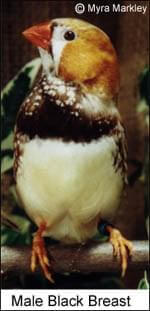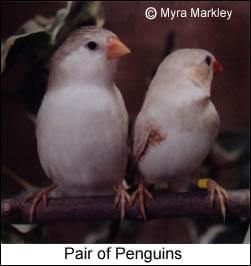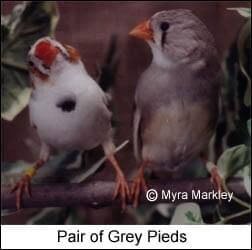Zebra Finch Color Mutations
..why so many colors
by Myra
Articles and Information - Lady Gouldian Finch
Zebra Finches breed easily and quickly in captivity. Mutation occurs all the time in nature, and are frequently encouraged in captive breeding programs. Combine those two factors with humans who like variety and you can get a wide range of colors from the finch. Because of the Gouldian finch mutations popularity, the Zebra finches various color mutations are becoming more noticed by the general public. Personally I think this is great, until they start asking me about the genetics and colors. Then their eyes glaze over in pure confusion as I explain the various mutations; how to spot them and how to produce more.
This is why I decided to write this article in layman's terms. To explain some of the confusion about the Zebra Finch mutations as simply as possible so you can identify and correctly breed these colors. I'm not going to cover some of the more technical aspects of genetics, I'll leave that to a true genetics experts, but I can help you to see the mutations and explain the traits. Please note I am only going to cover colors and not all of the color mutations available.
 Zebra Finch Color Mutations
Zebra Finch Color Mutations
There are three basic types of genes; Dominant, Recessive, and Sex-linked.
Dominant: Zebras will display this color even if only one parent has the gene. Zebras are never split for a dominant trait. They either are that color and show it, or they are not and don't carry it. With dominate mutations you don't need both parents to be of the same mutation. In fact it's best if one is a dominant mutation and the other is a Normal Grey or some other non-dominant mutation. Breeding a dominant mutation to something like a Grey will not produce the dominant trait in the young 100% of the time. It's actually more like 50% of the time. Half the young will show the trait, the other half will not. Greys are the only dominant mutations which should be bred together. Some dominant mutations are: Grey, Black Face, Dominant Silver, Grey Cheek, Fawn Cheek, and Crested.
Recessive: These color traits will only appear on the offspring if both parents also showed or carried these colors (split to). Recessive colors have a tendency to pop up when you least expect them. I have a pair of Grey Pieds who produce a variety of recessive colors in their offspring. Recessive traits can lay hidden in a family line for many generations until the right pairing brings the color out. When you breed two of the same recessive traits together your chances are better that more of the offspring will show the recessive trait, but those who do not show it will probably carry it while others may not. Being split to a mutation means the bird carries the trait but does not always show it. Some recessive mutations are: Grey, Pied, Yellow Beak, Isabel, Black Breast, Black Cheek, Orange Breast, White, Recessive Silver, and Penguin.
Sex-linked: As the name suggests, these colors are linked to the sex of the Zebra. Sex-linked genes in Zebras are on the females X chromosome. This means that if the female has this sex-link trait she'll show it. Males on the other hand don't necessarily have to show it, they can simply carry the gene. Males won't display the sex-linked genes unless both their parents show the color, or at least the father carries it while the female shows it. Some sex-linked mutations are: Fawn, Chestnut Flanked White, Light Back.
How do these genes work? For starters you need to know that it isn't one gene making a mutation, it's a large number of genes that actually produce the various color. You can easily have a finch with several mutations showing and several more hiding. An example would be a Black Face Recessive Silver Pied male who is split for Yellow Beak and Black Cheek. To bring the hidden or "split to" colors out in this birds offspring without loosing the original colors you would need to mate him to a female Recessive Silver Pied who is either Yellow Beak and Black Cheek or is split to Yellow Beak and Black Cheek.
A slightly less complex pairing would be to mate a Grey Yellow Beak male to a Grey who is split to Yellow Beak female. They are both grey, so all offspring will be grey as it's the most dominant color. They are both Yellow Beak, but that mutation is recessive so around 50% of the offspring will be Yellow Beak leaving the other 50% to carry the trait.
 Pair of Penguin Zebra Finches - by Myra Markley (FinchNiche)
Pair of Penguin Zebra Finches - by Myra Markley (FinchNiche)
When dealing with a dominant gene like Black Face you would pair a Black Face up with anything other than another Black Face. For example a Grey Black Face with a Grey, would produce all Greys with about half of them showing the Black face trait. Those who do not show the trait do not carry it. I am not saying if you have a clutch of 6 babies from the pair that 3 will be Black Face, the actual number can't be guessed, but each of the 6 have a 50/50 chance of showing the Black Face.
Sex-linked genes are headaches for many people only because they can be confusing. Mostly simply put they act like dominant genes in females and recessive genes in males. If you pair a Chestnut Flanked White female with a Chestnut Flanked White male you will get mostly Chestnut Flanked White offspring with a few Grey males who will carry the Chestnut Flanked White gene. If you pair a Chestnut Flanked White female with a Grey male you will get mostly Grey offspring with a Chestnut Flanked White female offspring. Several of the males will probably carry the gene. Pairing a Grey female to a Grey male who is split for Chestnut Flanked White will result in a few Chestnut Flanked White females but mostly Grey of both sexes.
Just how many Zebra mutations are there? A lot, with new mutations popping out from time to time. Last year I heard about a new Zebra mutation called the "George". It's a very distinctive mutation which is currently being bred to increase their numbers and further develop the colors. Personally I would love to have a breed a pair of these Georges but they are only available in Australia.
Grey - Original Wild-type; Usually dark grey but can actually be several shades of grey. Males have orange cheeks, Brown with white spotted flanking, Zebra striped throat markings, and a prominent black breast bar. Females lack all these extra colorations. Both sexes will have the black tear drop marking which starts below the eye and runs down the cheek.
Black Breast - This is one of my favorite mutations. Males can have a large breast bar and cheek patch that are twice the normal size extending to the back of the head. Flanks are normal colored to more reddish with elongated white dots. Both sexes will lack the black tear mark and have a distinctive white breast and rump.
Black Cheek - The Black Cheek is becoming very popular to first time Zebra finch breeders because of its unusual appearance. Both sexes share the very Black Cheek patches. Even the flanking on the males can be black with white dots, tho brown is more commonly found. A full Black Cheek should not be mated with another full Black Cheek. For best results in offspring, mate a full Black Cheek to a bird who is split to Black Cheek.
Black Face - Black Faced Zebras are black over the entire facial area (between beak and the eye) the and most of the breast and underparts black. The flanking is often completely red to brown with few if any white dots. The females can also show the Black Face coloration but not to the intensity of the males. Females tends to have grey or silver faces. Combined with the Yellow Beak the Black Face are really striking to look at.
Chestnut Flanked White - Also called Marked White. Both sexes have white to ivory body color. Males have a breast bar, cheek patch and flanking as normal, but these markings are generally diluted by comparison to Greys. Females are white with black tear drop mark.
Crested - This mutation has a rosette of feathers on the center-top of the head in both sexes. Some have a full crest, some have only a semi circle crest, and others have feathers which stand upright; these I refer to as my "bad hair cut birds".
Dominant Silver - Body color is a silver-grey or bluish color, can resemble the Recessive Silver mutation but male Pastels have cream to white cheeks and flanking color, no orange at all. They are a darker color than the Recessive Silvers.
 Zebra Finch Color Mutations - Male Orange Breast Zebra
Zebra Finch Color Mutations - Male Orange Breast Zebra
Fawn - Body is a rich cinnamon-brown or tan body color in both sexes. Males will retain the typical colorations. Fawns are frequently available in pet stores as they are common, frequently found as females because this is a sex-linked gene.
Fawn Cheek and Grey Cheek - The birds closely resemble Florida Fancies, but Males have a darker breast bar and tear drop markings. The cheek patches occur on both males and females . The males cheek color varies from shades of orange-fawn to grey. The body is silvery white to cream, The male's breast bar combined with unique body color make this very beautiful. Fawn Cheeks and Grey Cheeks should never be mated with one another because they are both dominant traits
Florida Fancy (Isabel) - Also known as Isabel. Bright white to slightly cream body color, with distinct buff color underparts. Male retains full color in cheeks and flanking and has no breast bar, nor any black. Females appear pure white to slightly cream and also lack all black markings. Florida Fancy females and Chestnut Flanked White females can be easily recognized as different because of the Florida Fancies missing tear mark.
Light Back - Light Backs have a dilute upper body color and all underparts, breast and vent region are white. Tail coverts have bright white markings in both sexes. Males have distinct bright cream cheek patches and flanking making. The black areas such as the breast bar and tail are not dilute but fully black.
Orange Breast - This one is easy to spot. In the best examples of Orange Breast you'll notice that all the black markings are replaced with orange. Of course you will find many Orange Breast whom have mostly orange with a few flecks of black still visible. Hens look normal with the exception of orange in the tail covert bars.
Penguin - This is a very neat looking mutation but it's frequently confused with Pieds. Both sexes will have a dark upper body and wings laced with silver-white markings. Upper breast and underparts are bright white. Males will not have the breast bar markings. The males' cheeks and flanking are the typical colors though sometimes diluted slightly. Females are striking with white cheek area, bright white breast and underparts, but they don't show the black tear mark.
 Pair of Grey Pied Zebra Finches - ladygouldianfinch.com
Pair of Grey Pied Zebra Finches - ladygouldianfinch.com
Pied - Pied is my favorite mutation, mostly because no two Pieds are exactly alike. To be Pied simply means that the normal body color such as Grey or Fawn is broken with patches of white coloration. Pied can be combined with any other mutation but look the most striking on the darker colors. White Zebras can also be Pied but you'll never see the Pied factor until you breed in a darker mutation or Grey.
Recessive Silver - Over all are a light silver gray color. Males retain full orange color in cheeks and colors in flanking. Females again lack all the special coloring except for the light silver grey body color.
White - A solid white bird. Sexed only by beak color. Males will have the red beaks, females have pale orange beaks. If your white Zebra has some pearling (silver to very light grey spots) on its back it's possibly Pied.
Yellow Beak - The Yellow Beak Zebra is an old variety, and both sexes have the pale yellow beaks. I've found it to be a very attractive mutation on the darker Zebras such as the Black Face, Black Breast, and Greys.
Contrary to what many people have said and believe, there is no albino mutation of the Zebra finch known to exist. Granted that fact is very hard to believe considering albinism happens in many other species of animal, but to this day no one has produced a truly albino Zebra. To be a true albino means all coloration pigments are absent, the finch would be pure white with pink eyes and white or very pale beak and legs. Many people who have claimed to have and be breeding albinos have in fact been breeding white Zebras sometimes even Yellow Beak white Zebras, but they are not true albinos. You may even see a Zebra with red eyes. They are found here in the US but are much more common in Europe and Australia. The red eye trait is simply an eye color and has no relation to albinism. Why are there no albinos? I don't know. The Zebra breeding community around the world doesn't really know either.
Naturally all these mutations, being that they are all the same species, can be bred together. After years of breeding and recording family lines many interesting color combinations have been produced, one of which is the Phaeo. The Phaeo isn't a mutation but rather the combination of Black Breast and Florida Fancy. These birds are almost entirely white and orange. The most magnificent Phaeo image I have seen was of an Orange Faced Phaeo, or a bird which is Black Face Black Breast and Florida Fancy combo.
© lady gouldian finch.com 2017